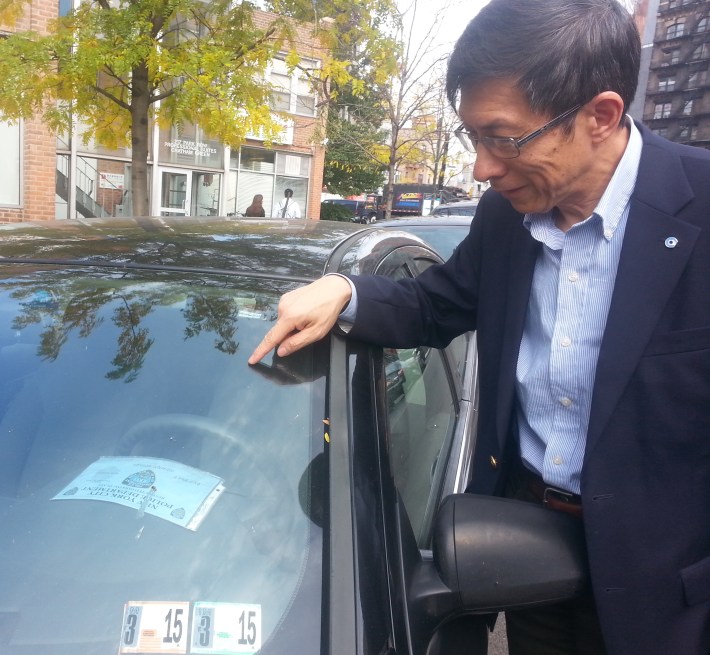Imagine if your neighborhood's streets were used as an employee parking lot for a nearby office building, and the people in charge of enforcing the rules turned a blind eye, day in and day out, as they ticketed members of the public but ignored lawbreaking by their colleagues.
Well, there's no need to imagine: That's how parking works in Chinatown, and leaders from the Chinatown Partnership Local Development Corporation are fed up after years of abuse.

The Partnership inventoried the neighborhood's parking supply in August, looking at regulations and conditions for the approximately 3,000 on-street parking spaces within the BID's service area, which is roughly bounded by Broome Street, Broadway, Worth Street, and Allen Street [PDF]. During the peak of summer vacation, the BID found that 24.4 percent of all on-street parking spots in that area were taken up by cars with government placards.
In recent years, the city and state have reduced the total number of placards available, but the streets of Chinatown continue to fill with private cars displaying government placards, sitting by the curb all day like it's an employee parking lot. The Partnership isn't the first to document this longstanding problem. A 2006 study by Transportation Alternatives showed only 12 percent of permits in the southern section of Chinatown were being used legally [PDF]. A survey for an NYPD environmental impact statement in 2006 found more than 1,100 cars illegally using placards near One Police Plaza [PDF].
The problem is most pervasive in the neighborhood's southern end, which is full of courts and government offices. On a midday walk near the Partnership's Chatham Square headquarters, more than half the parking spots were occupied by placard holders. “Chinatown’s largest population are government workers," said Wellington Chen, the Partnership's executive director. “We are far and above the single most affected community.”
Chen, whose group has proposed car-free streets in the past, said the glut of placards has a negative impact on local businesses. Although most people get to Chinatown by transit, he said, some customers drive to the neighborhood because it is a regional destination. The perception that there's no parking available in Chinatown has driven customers in cars to competing neighborhoods like Flushing or Sunset Park.
"If you are going to take up a parking spot, please have your three meals that day in Chinatown to make up for what you took," Chen said of the placard parkers. “When something is out of kilter, when something is out of balance, it’s time to rebalance it.”
After September 11, the 400-space parking garage beneath One Police Plaza was closed to the public, and many of the surrounding streets along Park Row became private driveways for police and court buildings.
A 2008 report from the Asian American Federation of New York recommended construction of a new parking garage to replace the one closed at One Police Plaza [PDF]. But adding more parking to a neighborhood already burdened by traffic is a bad idea -- never mind figuring out what should be demolished to accommodate more parking in dense Chinatown.
Chen says it's important to wring the most value out of the neighborhood's existing parking spaces before discussing whether more should even be built. “Would a public garage with reasonable, affordable rates be useful? Yes," he said. "But if you manage on-street parking, you can save millions of dollars... The greatest bang for the buck is to use the existing resources on the ground."
DOT's Park SMART program aims to increase parking turnover by recalibrating meter rates. But the placard problem in Chinatown would throw a wrench into any attempt to put a better price on parking. Park SMART has run into some trouble along Atlantic Avenue, for instance, where Corrections Department staff continue to park all day with impunity. If police don't enforce the rules so that placards aren't used as all-day free parking passes, changes to the rules are next to useless.
Chen acknowledged that placard enforcement is a "sensitive" issue with NYPD. “Sometimes they think we are raising the issue because we are targeting NYPD. That is not the case," he said. “At the end of the day, you know what [lack of enforcement] does? It undermines the trust. It undermines the work that Bill Bratton is trying to do.”
Council Member Margaret Chin shares the Partnership's frustration. “If you need a space for the whole day, then you need to find a parking garage," she said when asked about placard parking at a recent event. “Enforce the law. I mean, it’s very clear and simple. Enforce the law."





